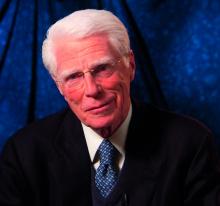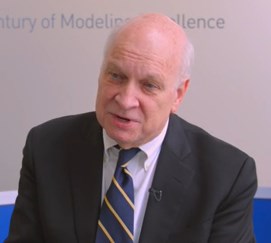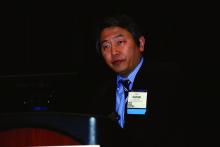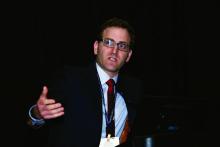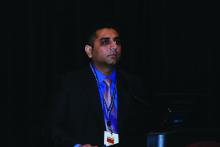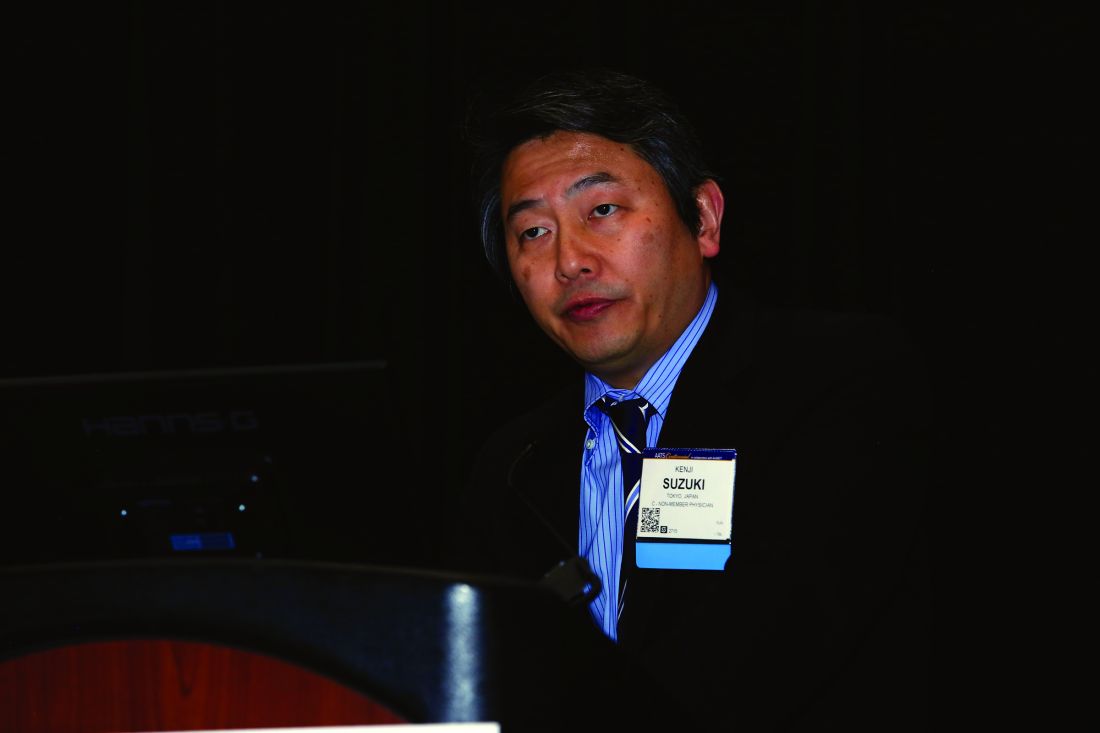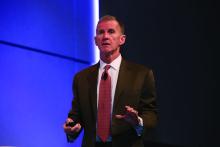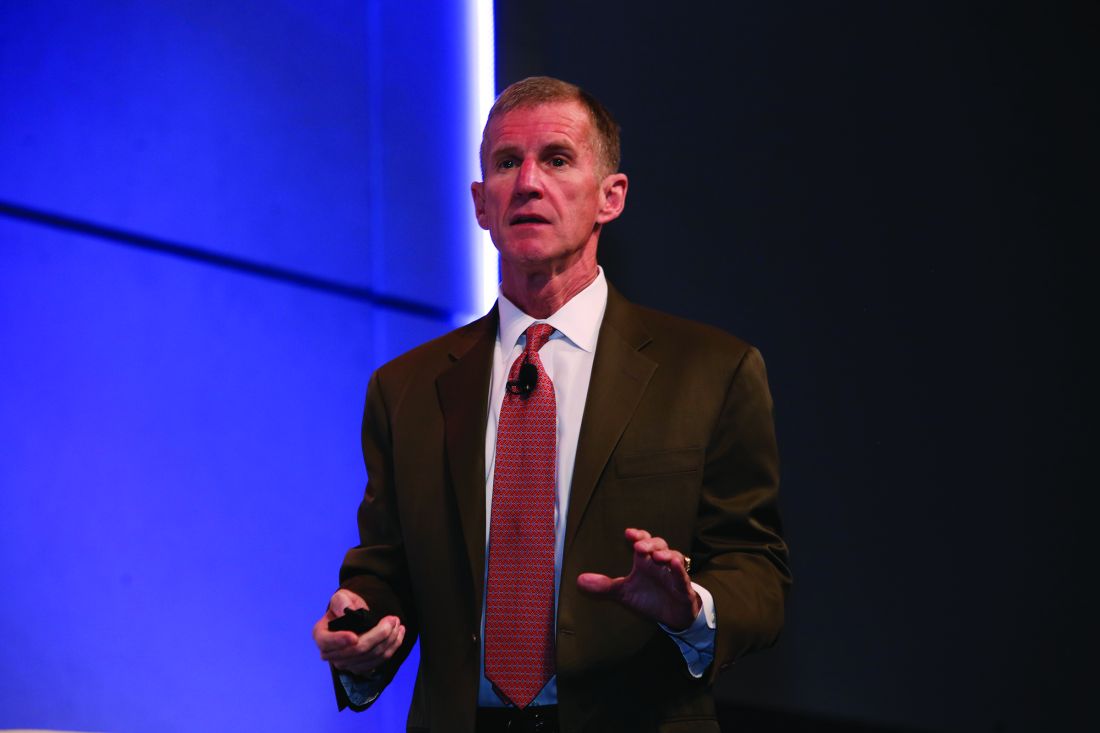User login
Announcing the 2018 Lifetime Achievement and Scientific Achievement Award Recipients
The American Association for Thoracic Surgery is recognizing the contributions of two giants in the field with two of its highest honors. The AATS will present its Lifetime Achievement Award to Aldo R. Castaneda and the Scientific Achievement Award to Magdi Yacoub on April 30, 2018, during the Plenary Session of the AATS Annual Meeting in San Diego, California.
The Lifetime Achievement Award recognizes individuals for their significant contributions to the specialty in the areas of patient care, teaching, research or community service. Dr. Castaneda, who served as the 74th President of the AATS in 1993-94, is the eighth recipient of the award since it was established in 2004.
His humanism has been a part of his work from early on in his career and now in his retirement, he continues to contribute to the well-being of the underserved people of Guatemala through the Aldo Castaneda Foundation.
In 1994, the Association established its Scientific Achievement Award to recognize individuals who have made extraordinary scientific contributions to the field of cardiothoracic surgery. Dr. Yacoub joins 12 other colleagues as a recipient of the highest scientific recognition this Association can bestow upon a surgeon.
As one of the busiest adult, congenital and thoracic transplant surgeons in the world over a very long career, he has always placed basic science and innovation on equal footing with performing operations. His dedication to patients throughout the world continues with his current efforts to develop the Aswan Heart Center to care for the indigent.
The American Association for Thoracic Surgery is recognizing the contributions of two giants in the field with two of its highest honors. The AATS will present its Lifetime Achievement Award to Aldo R. Castaneda and the Scientific Achievement Award to Magdi Yacoub on April 30, 2018, during the Plenary Session of the AATS Annual Meeting in San Diego, California.
The Lifetime Achievement Award recognizes individuals for their significant contributions to the specialty in the areas of patient care, teaching, research or community service. Dr. Castaneda, who served as the 74th President of the AATS in 1993-94, is the eighth recipient of the award since it was established in 2004.
His humanism has been a part of his work from early on in his career and now in his retirement, he continues to contribute to the well-being of the underserved people of Guatemala through the Aldo Castaneda Foundation.
In 1994, the Association established its Scientific Achievement Award to recognize individuals who have made extraordinary scientific contributions to the field of cardiothoracic surgery. Dr. Yacoub joins 12 other colleagues as a recipient of the highest scientific recognition this Association can bestow upon a surgeon.
As one of the busiest adult, congenital and thoracic transplant surgeons in the world over a very long career, he has always placed basic science and innovation on equal footing with performing operations. His dedication to patients throughout the world continues with his current efforts to develop the Aswan Heart Center to care for the indigent.
The American Association for Thoracic Surgery is recognizing the contributions of two giants in the field with two of its highest honors. The AATS will present its Lifetime Achievement Award to Aldo R. Castaneda and the Scientific Achievement Award to Magdi Yacoub on April 30, 2018, during the Plenary Session of the AATS Annual Meeting in San Diego, California.
The Lifetime Achievement Award recognizes individuals for their significant contributions to the specialty in the areas of patient care, teaching, research or community service. Dr. Castaneda, who served as the 74th President of the AATS in 1993-94, is the eighth recipient of the award since it was established in 2004.
His humanism has been a part of his work from early on in his career and now in his retirement, he continues to contribute to the well-being of the underserved people of Guatemala through the Aldo Castaneda Foundation.
In 1994, the Association established its Scientific Achievement Award to recognize individuals who have made extraordinary scientific contributions to the field of cardiothoracic surgery. Dr. Yacoub joins 12 other colleagues as a recipient of the highest scientific recognition this Association can bestow upon a surgeon.
As one of the busiest adult, congenital and thoracic transplant surgeons in the world over a very long career, he has always placed basic science and innovation on equal footing with performing operations. His dedication to patients throughout the world continues with his current efforts to develop the Aswan Heart Center to care for the indigent.
Save the Date: 2017 AATS Focus on Thoracic Surgery: Mastering Surgical Innovation
Mark your calendar for the 2017 AATS Focus on Thoracic Surgery meeting taking place in a new location this year - Las Vegas.
October 27-28, 2017
Encore at Wynn Las Vegas
Las Vegas, Nevada, USA
Program Directors
G. Alexander Patterson
David S. Sugarbaker
Program Committee
Thomas A. D’Amico
Shaf Keshavjee
James D. Luketich
Bryan F. Meyers
Scott J. Swanson
Traves D. Crabtree
For more informaton, go to:
aats.org/focus
Mark your calendar for the 2017 AATS Focus on Thoracic Surgery meeting taking place in a new location this year - Las Vegas.
October 27-28, 2017
Encore at Wynn Las Vegas
Las Vegas, Nevada, USA
Program Directors
G. Alexander Patterson
David S. Sugarbaker
Program Committee
Thomas A. D’Amico
Shaf Keshavjee
James D. Luketich
Bryan F. Meyers
Scott J. Swanson
Traves D. Crabtree
For more informaton, go to:
aats.org/focus
Mark your calendar for the 2017 AATS Focus on Thoracic Surgery meeting taking place in a new location this year - Las Vegas.
October 27-28, 2017
Encore at Wynn Las Vegas
Las Vegas, Nevada, USA
Program Directors
G. Alexander Patterson
David S. Sugarbaker
Program Committee
Thomas A. D’Amico
Shaf Keshavjee
James D. Luketich
Bryan F. Meyers
Scott J. Swanson
Traves D. Crabtree
For more informaton, go to:
aats.org/focus
Apply for the Cardiothoracic Ethics Forum Scholarship
The Cardiothoracic Ethics Forum Scholarship, supported by the AATS and STS, provides opportunities for intellectual development and preparation for leadership roles in CT ethics.
The scholarships of up to $10,000 give interested CT surgeons the opportunity to obtain formal education and training in biomedical ethics through any of the several programs offered by leading ethics centers in North America.
To be eligible to apply, applicants must be a member of either the AATS or STS. The application deadline is July 1.
For more information and to apply, please visit:
www.ctsnet.org/cardiothoracic-ethics-forum-scholarship
The Cardiothoracic Ethics Forum Scholarship, supported by the AATS and STS, provides opportunities for intellectual development and preparation for leadership roles in CT ethics.
The scholarships of up to $10,000 give interested CT surgeons the opportunity to obtain formal education and training in biomedical ethics through any of the several programs offered by leading ethics centers in North America.
To be eligible to apply, applicants must be a member of either the AATS or STS. The application deadline is July 1.
For more information and to apply, please visit:
www.ctsnet.org/cardiothoracic-ethics-forum-scholarship
The Cardiothoracic Ethics Forum Scholarship, supported by the AATS and STS, provides opportunities for intellectual development and preparation for leadership roles in CT ethics.
The scholarships of up to $10,000 give interested CT surgeons the opportunity to obtain formal education and training in biomedical ethics through any of the several programs offered by leading ethics centers in North America.
To be eligible to apply, applicants must be a member of either the AATS or STS. The application deadline is July 1.
For more information and to apply, please visit:
www.ctsnet.org/cardiothoracic-ethics-forum-scholarship
Register for the 2017 AATS Focus on Thoracic Surgery: Lung and Esophageal Cancer
You can now register for the 2017 AATS Focus on Thoracic Surgery: Lung and Esophageal Cancer meeting.
Lung cancer and esophageal cancer remain a global concern for patients and thoracic surgeons as two of the deadliest malignancies worldwide. The 2017 AATS Focus on Thoracic Surgery: Lung and Esophageal Cancer meeting will concentrate on the complex issues involved with treating both lung and esophageal malignancies, while also discussing innovative approaches to improve quality and outcomes.
The two-day program features a mixture of lectures, relevant case studies, interactive panel discussions and videos. The faculty includes Chinese and internationally recognized experts in lung and esophageal disease ensuring attendees will receive insights from a broad spectrum of leaders in thoracic surgery.
June 30 - July 1, 2017
Beijing, National Conference Center
Beijing, China
Program Directors
G. Alexander Patterson
David J. Sugarbaker
Ke-Neng Chen
Jie He
For more information, visit: aats.org/focuschina
You can now register for the 2017 AATS Focus on Thoracic Surgery: Lung and Esophageal Cancer meeting.
Lung cancer and esophageal cancer remain a global concern for patients and thoracic surgeons as two of the deadliest malignancies worldwide. The 2017 AATS Focus on Thoracic Surgery: Lung and Esophageal Cancer meeting will concentrate on the complex issues involved with treating both lung and esophageal malignancies, while also discussing innovative approaches to improve quality and outcomes.
The two-day program features a mixture of lectures, relevant case studies, interactive panel discussions and videos. The faculty includes Chinese and internationally recognized experts in lung and esophageal disease ensuring attendees will receive insights from a broad spectrum of leaders in thoracic surgery.
June 30 - July 1, 2017
Beijing, National Conference Center
Beijing, China
Program Directors
G. Alexander Patterson
David J. Sugarbaker
Ke-Neng Chen
Jie He
For more information, visit: aats.org/focuschina
You can now register for the 2017 AATS Focus on Thoracic Surgery: Lung and Esophageal Cancer meeting.
Lung cancer and esophageal cancer remain a global concern for patients and thoracic surgeons as two of the deadliest malignancies worldwide. The 2017 AATS Focus on Thoracic Surgery: Lung and Esophageal Cancer meeting will concentrate on the complex issues involved with treating both lung and esophageal malignancies, while also discussing innovative approaches to improve quality and outcomes.
The two-day program features a mixture of lectures, relevant case studies, interactive panel discussions and videos. The faculty includes Chinese and internationally recognized experts in lung and esophageal disease ensuring attendees will receive insights from a broad spectrum of leaders in thoracic surgery.
June 30 - July 1, 2017
Beijing, National Conference Center
Beijing, China
Program Directors
G. Alexander Patterson
David J. Sugarbaker
Ke-Neng Chen
Jie He
For more information, visit: aats.org/focuschina
Don’t Miss the 2017 AATS International Cardiovascular Symposium
Make your plans to attend the 2017 AATS International Cardiovascular Symposium.
December 8-9, 2017
Renaissance São Paulo Hotel
São Paulo, Brazil
Program Directors
Joseph S. Coselli
Walter J. Gomes
Marc R. Moon
Thoralf M. Sundt, III
For more information, go to: aats.org/ics
Make your plans to attend the 2017 AATS International Cardiovascular Symposium.
December 8-9, 2017
Renaissance São Paulo Hotel
São Paulo, Brazil
Program Directors
Joseph S. Coselli
Walter J. Gomes
Marc R. Moon
Thoralf M. Sundt, III
For more information, go to: aats.org/ics
Make your plans to attend the 2017 AATS International Cardiovascular Symposium.
December 8-9, 2017
Renaissance São Paulo Hotel
São Paulo, Brazil
Program Directors
Joseph S. Coselli
Walter J. Gomes
Marc R. Moon
Thoralf M. Sundt, III
For more information, go to: aats.org/ics
Register for the AATS Surgical Treatment of Arrhythmias and Rhythm Disorders 2017
Don’t miss this two-day, interactive forum that supports the exchange of information between electrophysiologists and surgeons.
November 17-18, 2017
Nobu Eden Roc Hotel
Miami Beach FL USA
Program Overview
The AATS Surgical Treatment of Arrhythmias and Rhythm Disorders provides a comprehensive, unbiased review of the surgical treatment of cardiac arrhythmias and rhythm disorders. The meeting will cover basic underlying mechanisms, cardiac recording and mapping techniques, clinical electrophysiology, operative techniques, cardiac monitoring and appropriate follow-up. The esteemed faculty will cover: interventional approaches to atrial fibrillation, ventricular tachycardia, inappropriate sinus tachycardia, and transvenous and epicardial lead implantation and extraction techniques.
Program Directors
Ralph J. Damiano, Jr.
A. Marc Gillinov
Program Committee
Niv Ad
Vinay Badhwar
Manuel Castella
James L. Cox
Mark LaMeir
Patrick M. McCarthy
Takashi Nitta
Harold G. Roberts
Richard Schuessler
To register and reserve housing, go to: www.aats.org/stars
Don’t miss this two-day, interactive forum that supports the exchange of information between electrophysiologists and surgeons.
November 17-18, 2017
Nobu Eden Roc Hotel
Miami Beach FL USA
Program Overview
The AATS Surgical Treatment of Arrhythmias and Rhythm Disorders provides a comprehensive, unbiased review of the surgical treatment of cardiac arrhythmias and rhythm disorders. The meeting will cover basic underlying mechanisms, cardiac recording and mapping techniques, clinical electrophysiology, operative techniques, cardiac monitoring and appropriate follow-up. The esteemed faculty will cover: interventional approaches to atrial fibrillation, ventricular tachycardia, inappropriate sinus tachycardia, and transvenous and epicardial lead implantation and extraction techniques.
Program Directors
Ralph J. Damiano, Jr.
A. Marc Gillinov
Program Committee
Niv Ad
Vinay Badhwar
Manuel Castella
James L. Cox
Mark LaMeir
Patrick M. McCarthy
Takashi Nitta
Harold G. Roberts
Richard Schuessler
To register and reserve housing, go to: www.aats.org/stars
Don’t miss this two-day, interactive forum that supports the exchange of information between electrophysiologists and surgeons.
November 17-18, 2017
Nobu Eden Roc Hotel
Miami Beach FL USA
Program Overview
The AATS Surgical Treatment of Arrhythmias and Rhythm Disorders provides a comprehensive, unbiased review of the surgical treatment of cardiac arrhythmias and rhythm disorders. The meeting will cover basic underlying mechanisms, cardiac recording and mapping techniques, clinical electrophysiology, operative techniques, cardiac monitoring and appropriate follow-up. The esteemed faculty will cover: interventional approaches to atrial fibrillation, ventricular tachycardia, inappropriate sinus tachycardia, and transvenous and epicardial lead implantation and extraction techniques.
Program Directors
Ralph J. Damiano, Jr.
A. Marc Gillinov
Program Committee
Niv Ad
Vinay Badhwar
Manuel Castella
James L. Cox
Mark LaMeir
Patrick M. McCarthy
Takashi Nitta
Harold G. Roberts
Richard Schuessler
To register and reserve housing, go to: www.aats.org/stars
Take Part in the Heart Valve Summit: Medical, Surgical and Interventional Decision Making
Join the American College of Cardiology and the American Association for Thoracic Surgery as they once again bring together cardiologists and surgeons in a cooperative, case-based course to address the rapid advances in the treatment of valvular heart disease.
October 5-7, 2017
Radisson Blu Aqua Hotel
Chicago, IL, USA
Program Overview
With the tradition of interactivity and practical decision making, the unique Heart Valve Summit is designed to engage participants in discussions, debates and potential controversies surrounding real-world cases. A renowned faculty on the cutting edge of clinically relevant data for valvular heart disease management will lead this interdisciplinary course that combines the most relevant medical, surgical and interventional options for patient care.
Course Directors
David H. Adams
Steven F. Bolling
Robert O. Bonow
Howard C. Herrmann
Nurse Planner
Michele Mistovich
To register and reserve housing, visit: www.aats.org/valve
Join the American College of Cardiology and the American Association for Thoracic Surgery as they once again bring together cardiologists and surgeons in a cooperative, case-based course to address the rapid advances in the treatment of valvular heart disease.
October 5-7, 2017
Radisson Blu Aqua Hotel
Chicago, IL, USA
Program Overview
With the tradition of interactivity and practical decision making, the unique Heart Valve Summit is designed to engage participants in discussions, debates and potential controversies surrounding real-world cases. A renowned faculty on the cutting edge of clinically relevant data for valvular heart disease management will lead this interdisciplinary course that combines the most relevant medical, surgical and interventional options for patient care.
Course Directors
David H. Adams
Steven F. Bolling
Robert O. Bonow
Howard C. Herrmann
Nurse Planner
Michele Mistovich
To register and reserve housing, visit: www.aats.org/valve
Join the American College of Cardiology and the American Association for Thoracic Surgery as they once again bring together cardiologists and surgeons in a cooperative, case-based course to address the rapid advances in the treatment of valvular heart disease.
October 5-7, 2017
Radisson Blu Aqua Hotel
Chicago, IL, USA
Program Overview
With the tradition of interactivity and practical decision making, the unique Heart Valve Summit is designed to engage participants in discussions, debates and potential controversies surrounding real-world cases. A renowned faculty on the cutting edge of clinically relevant data for valvular heart disease management will lead this interdisciplinary course that combines the most relevant medical, surgical and interventional options for patient care.
Course Directors
David H. Adams
Steven F. Bolling
Robert O. Bonow
Howard C. Herrmann
Nurse Planner
Michele Mistovich
To register and reserve housing, visit: www.aats.org/valve
VIDEO: Incoming AATS president outlines goals
BOSTON – Strengthening member engagement is a top goal for incoming AATS President Duke E. Cameron, MD.
In this video, Dr. Cameron, of Massachusetts General Hospital, Boston, shared his objectives as the next AATS leader and the direction he envisions for the specialty over the next 100 years. Dr. Cameron also discussed his hope for new online educational efforts and the importance of physician collaboration with other health professionals.
On Twitter @legal_med
BOSTON – Strengthening member engagement is a top goal for incoming AATS President Duke E. Cameron, MD.
In this video, Dr. Cameron, of Massachusetts General Hospital, Boston, shared his objectives as the next AATS leader and the direction he envisions for the specialty over the next 100 years. Dr. Cameron also discussed his hope for new online educational efforts and the importance of physician collaboration with other health professionals.
On Twitter @legal_med
BOSTON – Strengthening member engagement is a top goal for incoming AATS President Duke E. Cameron, MD.
In this video, Dr. Cameron, of Massachusetts General Hospital, Boston, shared his objectives as the next AATS leader and the direction he envisions for the specialty over the next 100 years. Dr. Cameron also discussed his hope for new online educational efforts and the importance of physician collaboration with other health professionals.
On Twitter @legal_med
AT THE AATS ANNUAL MEETING
NSCLC Was a Key Focus of General Thoracic Session
The initial results of a phase III randomized trial comparing lobectomy to segmentectomy for small, peripheral non–small cell lung cancer (NSCLC) were presented by Kenji Suzuki, MD, of the Juntendo University Hospital, Japan.
Segmentectomy and lobectomy both proved feasible techniques for early-stage NSCLC. However, segmentectomy did not appear to be less invasive than lobectomy with regard to blood loss or the frequency of air leak, according to Dr. Suzuki.
A total of 1,106 patients (554 in lobectomy arm; 552 in segmentectomy arm) were enrolled between August 2009 and October 2014. There were 22 patients whose mode of surgery was converted from segmentectomy to lobectomy in the segmentectomy arm, resulting in 576 lobectomies and 530 segmentectomies.
“The aim of the trial is to confirm the non-inferiority in overall survival (OS) of segmentectomy, compared with lobectomy,” said Dr. Suzuki.
Surgical complications were evaluated by the mode of surgery with an intention-to-treat analysis. As to a mode of surgery, segmentectomy was categorized into simple and complex in terms of technical difficulty; resection of the right or left S6, the left superior, and the lingular segment were defined as simple, because these procedures are easy and common.
Operative mortality was 0% in both groups. Postoperative complications, including pneumonia were not significantly different between the two groups. However, there was a significant difference in the rate of air leak detected: 3.8% in Group A and 6.5% in Group B (with no broncho-pleural fistulas being found).
Multivariate analysis showed that pack-year (PY) smoking greater than 20 vs. none was a significant predictor of postoperative complications. Significant predictors of pulmonary complications, including alveolar fistula and empyema, were typical segmentectomy (vs. lobectomy); and PY greater than 20 vs. none.
“The primary analysis of this study is planned for 2020,” said Dr. Suzuki. Those results should help to determine whether segmentectomy should be considered the standard of treatment, compared to lobectomy.
Previous research has shown that a wedge resection (WR) may be superior to stereotactic body radiation therapy (SBRT) for patients with early-stage non–small cell lung cancer (NSCLC). However, the role that the quality of the WR plays in improved outcomes is unknown, according to Seth Krantz, MD, of the NorthShore University Health System who presented the results of a database analysis of patients within the National Cancer Database (NCDB) with clinical T1-T2, N0, M0 NSCLC patients who were treated with either WR or SBRT from 2005-2012. These patients were analyzed for surgical quality markers, predictors of lymph node assessment and pathologic upstaging, and overall survival. Quality markers included the number of nodes examined and margins status.
Of more than 7,000 WR patients included (44%) had 0 LNs examined; 37% had 1-5 examined, and nearly 17% had more than 5 nodes examined. Significant predictors of having at least 5 nodes examined included younger age, fewer comorbidities, T2 tumors, and obtaining negative margins. Negative margins were obtained in the vast majority of WR patients.
“Our study confirms that nationwide, while most patients undergoing wedge resection for early stage disease receive a margin negative resection, fewer than 20% of patients had more than five lymph nodes assessed, and nearly half had no lymph nodes assessed. Pathologic assessment of lymph nodes was associated with improved long-term survival and greater utilization of adjuvant chemotherapy. Furthermore, the benefit of a wedge resection compared to SBRT, was significantly affected by the extent of lymph node assessment.
If patients are going to be offered a wedge resection for early stage non-small cell lung cancer, every effort should be made to perform a pathologic assessment of regional lymph nodes,” Dr. Krantz concluded.
Patients at high risk for non–small cell lung cancer (NSCLC) metastases were found to have a significant rate of unsuspected lymph node metastases upon endosonographic assessment, even in the presence of radiologically normal mediastinal lymph nodes, according to a study reported by Pravachan Hegde, MD, of the University of Montreal.
A total of 22 out of 161 patients with radiologically normal mediastinum were found to be positive on combined EBUS/EUS staging. “Given the significant rate of unsuspected lymph node metastases, combined endosonographic lymph node staging should be routinely performed in staging of NSCLC in high risk patients even in the presence of radiologically normal mediastinal lymph nodes,” Dr. Hedge concluded.
The initial results of a phase III randomized trial comparing lobectomy to segmentectomy for small, peripheral non–small cell lung cancer (NSCLC) were presented by Kenji Suzuki, MD, of the Juntendo University Hospital, Japan.
Segmentectomy and lobectomy both proved feasible techniques for early-stage NSCLC. However, segmentectomy did not appear to be less invasive than lobectomy with regard to blood loss or the frequency of air leak, according to Dr. Suzuki.
A total of 1,106 patients (554 in lobectomy arm; 552 in segmentectomy arm) were enrolled between August 2009 and October 2014. There were 22 patients whose mode of surgery was converted from segmentectomy to lobectomy in the segmentectomy arm, resulting in 576 lobectomies and 530 segmentectomies.
“The aim of the trial is to confirm the non-inferiority in overall survival (OS) of segmentectomy, compared with lobectomy,” said Dr. Suzuki.
Surgical complications were evaluated by the mode of surgery with an intention-to-treat analysis. As to a mode of surgery, segmentectomy was categorized into simple and complex in terms of technical difficulty; resection of the right or left S6, the left superior, and the lingular segment were defined as simple, because these procedures are easy and common.
Operative mortality was 0% in both groups. Postoperative complications, including pneumonia were not significantly different between the two groups. However, there was a significant difference in the rate of air leak detected: 3.8% in Group A and 6.5% in Group B (with no broncho-pleural fistulas being found).
Multivariate analysis showed that pack-year (PY) smoking greater than 20 vs. none was a significant predictor of postoperative complications. Significant predictors of pulmonary complications, including alveolar fistula and empyema, were typical segmentectomy (vs. lobectomy); and PY greater than 20 vs. none.
“The primary analysis of this study is planned for 2020,” said Dr. Suzuki. Those results should help to determine whether segmentectomy should be considered the standard of treatment, compared to lobectomy.
Previous research has shown that a wedge resection (WR) may be superior to stereotactic body radiation therapy (SBRT) for patients with early-stage non–small cell lung cancer (NSCLC). However, the role that the quality of the WR plays in improved outcomes is unknown, according to Seth Krantz, MD, of the NorthShore University Health System who presented the results of a database analysis of patients within the National Cancer Database (NCDB) with clinical T1-T2, N0, M0 NSCLC patients who were treated with either WR or SBRT from 2005-2012. These patients were analyzed for surgical quality markers, predictors of lymph node assessment and pathologic upstaging, and overall survival. Quality markers included the number of nodes examined and margins status.
Of more than 7,000 WR patients included (44%) had 0 LNs examined; 37% had 1-5 examined, and nearly 17% had more than 5 nodes examined. Significant predictors of having at least 5 nodes examined included younger age, fewer comorbidities, T2 tumors, and obtaining negative margins. Negative margins were obtained in the vast majority of WR patients.
“Our study confirms that nationwide, while most patients undergoing wedge resection for early stage disease receive a margin negative resection, fewer than 20% of patients had more than five lymph nodes assessed, and nearly half had no lymph nodes assessed. Pathologic assessment of lymph nodes was associated with improved long-term survival and greater utilization of adjuvant chemotherapy. Furthermore, the benefit of a wedge resection compared to SBRT, was significantly affected by the extent of lymph node assessment.
If patients are going to be offered a wedge resection for early stage non-small cell lung cancer, every effort should be made to perform a pathologic assessment of regional lymph nodes,” Dr. Krantz concluded.
Patients at high risk for non–small cell lung cancer (NSCLC) metastases were found to have a significant rate of unsuspected lymph node metastases upon endosonographic assessment, even in the presence of radiologically normal mediastinal lymph nodes, according to a study reported by Pravachan Hegde, MD, of the University of Montreal.
A total of 22 out of 161 patients with radiologically normal mediastinum were found to be positive on combined EBUS/EUS staging. “Given the significant rate of unsuspected lymph node metastases, combined endosonographic lymph node staging should be routinely performed in staging of NSCLC in high risk patients even in the presence of radiologically normal mediastinal lymph nodes,” Dr. Hedge concluded.
The initial results of a phase III randomized trial comparing lobectomy to segmentectomy for small, peripheral non–small cell lung cancer (NSCLC) were presented by Kenji Suzuki, MD, of the Juntendo University Hospital, Japan.
Segmentectomy and lobectomy both proved feasible techniques for early-stage NSCLC. However, segmentectomy did not appear to be less invasive than lobectomy with regard to blood loss or the frequency of air leak, according to Dr. Suzuki.
A total of 1,106 patients (554 in lobectomy arm; 552 in segmentectomy arm) were enrolled between August 2009 and October 2014. There were 22 patients whose mode of surgery was converted from segmentectomy to lobectomy in the segmentectomy arm, resulting in 576 lobectomies and 530 segmentectomies.
“The aim of the trial is to confirm the non-inferiority in overall survival (OS) of segmentectomy, compared with lobectomy,” said Dr. Suzuki.
Surgical complications were evaluated by the mode of surgery with an intention-to-treat analysis. As to a mode of surgery, segmentectomy was categorized into simple and complex in terms of technical difficulty; resection of the right or left S6, the left superior, and the lingular segment were defined as simple, because these procedures are easy and common.
Operative mortality was 0% in both groups. Postoperative complications, including pneumonia were not significantly different between the two groups. However, there was a significant difference in the rate of air leak detected: 3.8% in Group A and 6.5% in Group B (with no broncho-pleural fistulas being found).
Multivariate analysis showed that pack-year (PY) smoking greater than 20 vs. none was a significant predictor of postoperative complications. Significant predictors of pulmonary complications, including alveolar fistula and empyema, were typical segmentectomy (vs. lobectomy); and PY greater than 20 vs. none.
“The primary analysis of this study is planned for 2020,” said Dr. Suzuki. Those results should help to determine whether segmentectomy should be considered the standard of treatment, compared to lobectomy.
Previous research has shown that a wedge resection (WR) may be superior to stereotactic body radiation therapy (SBRT) for patients with early-stage non–small cell lung cancer (NSCLC). However, the role that the quality of the WR plays in improved outcomes is unknown, according to Seth Krantz, MD, of the NorthShore University Health System who presented the results of a database analysis of patients within the National Cancer Database (NCDB) with clinical T1-T2, N0, M0 NSCLC patients who were treated with either WR or SBRT from 2005-2012. These patients were analyzed for surgical quality markers, predictors of lymph node assessment and pathologic upstaging, and overall survival. Quality markers included the number of nodes examined and margins status.
Of more than 7,000 WR patients included (44%) had 0 LNs examined; 37% had 1-5 examined, and nearly 17% had more than 5 nodes examined. Significant predictors of having at least 5 nodes examined included younger age, fewer comorbidities, T2 tumors, and obtaining negative margins. Negative margins were obtained in the vast majority of WR patients.
“Our study confirms that nationwide, while most patients undergoing wedge resection for early stage disease receive a margin negative resection, fewer than 20% of patients had more than five lymph nodes assessed, and nearly half had no lymph nodes assessed. Pathologic assessment of lymph nodes was associated with improved long-term survival and greater utilization of adjuvant chemotherapy. Furthermore, the benefit of a wedge resection compared to SBRT, was significantly affected by the extent of lymph node assessment.
If patients are going to be offered a wedge resection for early stage non-small cell lung cancer, every effort should be made to perform a pathologic assessment of regional lymph nodes,” Dr. Krantz concluded.
Patients at high risk for non–small cell lung cancer (NSCLC) metastases were found to have a significant rate of unsuspected lymph node metastases upon endosonographic assessment, even in the presence of radiologically normal mediastinal lymph nodes, according to a study reported by Pravachan Hegde, MD, of the University of Montreal.
A total of 22 out of 161 patients with radiologically normal mediastinum were found to be positive on combined EBUS/EUS staging. “Given the significant rate of unsuspected lymph node metastases, combined endosonographic lymph node staging should be routinely performed in staging of NSCLC in high risk patients even in the presence of radiologically normal mediastinal lymph nodes,” Dr. Hedge concluded.
McChrystal Spoke on the Need for a New Kind of Team
Monday’s Honored Guest Lecturer Gen. Stanley A. McChrystal, a retired four-star general, and former commander of U.S. and International Security Assistance Forces in Afghanistan, and of the Joint Special Operations Command, spoke on the transforming nature of leadership and teams.
His address, “Team of Teams – Rules of Engagement for a Complex World,” discussed how old organizational frameworks with a centralized leadership and silos of responsibility, similar to the standard organization charts that everyone is familiar with, are no longer sufficiently functional and efficient in a changing world. He stated how the world is not just complicated, but complex, and the nature of complexity means that it cannot be predicted and a rapid, adaptive response is necessary.He highlighted his experiences in Iraq where a terrorist group, rather than using a hierarchical organization such as Al Queda, organically developed a highly adaptable and diffuse structure, which allowed them to have their leaders taken out without heavily impacting their ability to grow and rapidly respond. It wasn’t until the U.S. military under his leadership emulated such a diffuse response and geared up their efforts many-fold, that the anti-terrorism effort began to succeed.
The cascade through the chain of command just wasn’t fast enough.“We had entered an environment where we had to resynchronize the organization every 24 hours. The entire organization.” So he established a daily conference call not just among the leadership but, instead, “connected everybody, all at the same time. We started by ordering 400 people to be on it and in a very short period of time it became 7,500, and went from 30 minutes to 90 minutes a day,” he said. And despite the fact that some people would call this ‘crazy,’ he said. “I’ll tell you it’s the most efficient thing I’ve ever been a part of in my life. In those 90 minutes, everyone in the organization got shared contextual understanding of what we were doing, what we were trying to do, and what we could do.” Leaders need to create an environment for a new kind of organization to grow.
Monday’s Honored Guest Lecturer Gen. Stanley A. McChrystal, a retired four-star general, and former commander of U.S. and International Security Assistance Forces in Afghanistan, and of the Joint Special Operations Command, spoke on the transforming nature of leadership and teams.
His address, “Team of Teams – Rules of Engagement for a Complex World,” discussed how old organizational frameworks with a centralized leadership and silos of responsibility, similar to the standard organization charts that everyone is familiar with, are no longer sufficiently functional and efficient in a changing world. He stated how the world is not just complicated, but complex, and the nature of complexity means that it cannot be predicted and a rapid, adaptive response is necessary.He highlighted his experiences in Iraq where a terrorist group, rather than using a hierarchical organization such as Al Queda, organically developed a highly adaptable and diffuse structure, which allowed them to have their leaders taken out without heavily impacting their ability to grow and rapidly respond. It wasn’t until the U.S. military under his leadership emulated such a diffuse response and geared up their efforts many-fold, that the anti-terrorism effort began to succeed.
The cascade through the chain of command just wasn’t fast enough.“We had entered an environment where we had to resynchronize the organization every 24 hours. The entire organization.” So he established a daily conference call not just among the leadership but, instead, “connected everybody, all at the same time. We started by ordering 400 people to be on it and in a very short period of time it became 7,500, and went from 30 minutes to 90 minutes a day,” he said. And despite the fact that some people would call this ‘crazy,’ he said. “I’ll tell you it’s the most efficient thing I’ve ever been a part of in my life. In those 90 minutes, everyone in the organization got shared contextual understanding of what we were doing, what we were trying to do, and what we could do.” Leaders need to create an environment for a new kind of organization to grow.
Monday’s Honored Guest Lecturer Gen. Stanley A. McChrystal, a retired four-star general, and former commander of U.S. and International Security Assistance Forces in Afghanistan, and of the Joint Special Operations Command, spoke on the transforming nature of leadership and teams.
His address, “Team of Teams – Rules of Engagement for a Complex World,” discussed how old organizational frameworks with a centralized leadership and silos of responsibility, similar to the standard organization charts that everyone is familiar with, are no longer sufficiently functional and efficient in a changing world. He stated how the world is not just complicated, but complex, and the nature of complexity means that it cannot be predicted and a rapid, adaptive response is necessary.He highlighted his experiences in Iraq where a terrorist group, rather than using a hierarchical organization such as Al Queda, organically developed a highly adaptable and diffuse structure, which allowed them to have their leaders taken out without heavily impacting their ability to grow and rapidly respond. It wasn’t until the U.S. military under his leadership emulated such a diffuse response and geared up their efforts many-fold, that the anti-terrorism effort began to succeed.
The cascade through the chain of command just wasn’t fast enough.“We had entered an environment where we had to resynchronize the organization every 24 hours. The entire organization.” So he established a daily conference call not just among the leadership but, instead, “connected everybody, all at the same time. We started by ordering 400 people to be on it and in a very short period of time it became 7,500, and went from 30 minutes to 90 minutes a day,” he said. And despite the fact that some people would call this ‘crazy,’ he said. “I’ll tell you it’s the most efficient thing I’ve ever been a part of in my life. In those 90 minutes, everyone in the organization got shared contextual understanding of what we were doing, what we were trying to do, and what we could do.” Leaders need to create an environment for a new kind of organization to grow.
